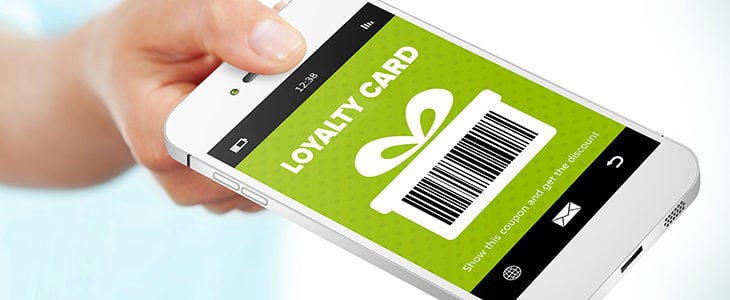Why Your Customer Loyalty Program is Failing and What To Do About It

It is commonly accepted that the cornerstone of any marketing strategy is lead generation. Increasing the volume of prospective customers for your product or service is the key to profitable growth, right?
Well… maybe not. The cost of attracting a new customer is five times more than the cost of retaining an existing customer. Furthermore, repeat customers spend, on average, 67% more than new customers.
So how do you grow customer loyalty in an age of increasing brand apathy?
The solution is simple: Make your mobile presence a key pillar of your customer loyalty program.
Why loyalty programs fail
Today, more than 90% of B2C companies have some kind of customer engagement or loyalty program. Studies have shown that consumers will join up to 14 loyalty programs but are only likely to be active on six or seven of them. Irrelevant and impersonal offers, low-value promotions, and over-communication are three of the top reasons why loyalty programs continue to suffer from low engagement and high attrition.
The fact is that consumers have high expectations of brand experiences and continue to drive low-performing brands outside the realm of relevance. Building a loyalty program people actually use is, apparently, easier said than done.
Due to the pandemic, companies are relying on maintaining loyal customers rather than creating new ones right now. In a post-COVID world, it may take things a little longer to get back to business as usual. Now is the time to think about ways to build and maintain healthy relationships with your customers.
When the pandemic reached the U.S., consumers strayed away from traditional shopping habits and began stockpiling goods—leaving many brands completely out of stock. With depleted inventories of their favorite brands, more than 75% consumers tried new brands or places to shop, according to a 2021 McKinsey report, citing product availability as the number one reason they sought out new retailers or products.
2020 brought a major shock to loyalty and consumers continue to explore new brands and shopping methods.
How native mobile applications can help loyalty programs succeed
The mobile channel is one that, when executed thoughtfully, can deliver exactly what traditional loyalty programs cannot—relevant, timely, personalized, valuable promotions that inspire purchase intent where little or none existed before.
Here are three major ways native mobile applications can increase the efficacy of a loyalty program:
- Convenience and consistency
75% of consumers expect a consistent experience wherever they engage with a brand, regardless of the channel (website, social media, mobile, in person). Additional features such as mobile payment options are both convenient for users and another way for brands to track and incentivize purchase behavior. As customers become more comfortable with the technology, mobile payments will be a catalyst for higher mobile-commerce sales.
- Personalized communication
Companies ranked personalization and relevance as the most important customer engagement-related trend for businesses in the next five years.
With mobile technology, brands can serve notifications based on user proximity to a physical storefront location, deliver targeted offers based on weather conditions, gamify the rewards program experience, and more.
Related: What You Need to Know About Data Privacy for Mobile Apps
The mobile channel gives companies a more complete view of how customers interact with their brand in their everyday lives. This presents a unique opportunity for marketers to swear off promotions crafted without regard for a customer’s interest in or ability to redeem them. - Engagement
Highly engaged customers buy 90% more often and spend 60% more per transaction.
A holistic mobile loyalty program has the potential to go beyond rewards points and sales promotions and become a viable, interactive communications channel. Instant access to FAQs, customer service reps via chat, in-store walking directions to specific departments, in-app charitable giving options, product or service review requests, and user-generated content sharing are just some of the ways that a mobile loyalty program can engage a consumer beyond the first transaction.
Mobile loyalty programs in practice
Royal Farms, a popular mid-Atlantic “quick and friendly” restaurant chain, decided to redesign its mobile app to create a fast, easy, and enjoyable experience for all of its customers. Based on user feedback, they made sure the new app makes customers feel rewarded for their continued patronage.
Customers can quickly scan their rewards barcode from the app and if they have it tied to RoFo Pay, it can be used to pay for purchases at any one of their 175+ stores.
The app’s key functionality was created with the goal of improving the speed and convenience of being a repeat customer, thus positioning themselves to increase the lifetime value of each and every user.
From rewards to relationships
Brands that are succeeding with mobile loyalty programs understand it takes more than a universal discount code to build a strong and lasting relationship with customers. According to HelloWorld’s 2019 Loyalty Barometer Report, consumers said they believe the most important way brands can interact with them is by “surprising [them] with offers and rewards.” These surprises can help drive emotional loyalty and build true brand connections.
Some companies that have successfully implemented these initiatives are online clothing retailer StitchFix, cosmetic line Tarte, and leading apparel line The North Face. They’re making loyalty rewards convenient to collect and redeem, delivering relevant content at the right time, and using the mobile channel as a forum for interactive engagement on the customer’s terms.
As brands look to evolve their loyalty strategies to better compete in a digital environment, it is important to remember that no one is loyal to brands that deliver bad experiences. The onus is on companies to embed positive experiences as part of the customer journey and treat loyalty as an outcome, instead of a scheme.

